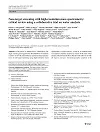In this article, a dataset from a collaborative non-target screening trial organised by the NORMAN Association is used to review the state-of-the-art and discuss future perspectives of non-target screening using high-resolution mass spectrometry in water analysis. A total of 18 institutes from 12 European countries analysed an extract of the same water sample collected from the River Danube with either one or both of liquid and gas chromatography coupled with mass spectrometry detection. This article focuses mainly on the use of high resolution screening techniques with target, suspect, and non-target workflows to identify substances in environmental samples. Specific examples are given to emphasise major challenges including isobaric and co-eluting substances, dependence on target and suspect lists, formula assignment, the use of retention information, and the confidence of identification. Approaches and methods applicable to unit resolution data are also discussed. Although most substances were identified using high resolution data with target and suspect-screening approaches, some participants proposed tentative non-target identifications. This comprehensive dataset revealed that non-target analytical techniques are already substantially harmonised between the participants, but the data processing remains time-consuming. Although the objective of a “fully-automated identification workflow” remains elusive in the short term, important steps in this direction have been taken, exemplified by the growing popularity of suspect screening approaches. Major recommendations to improve non-target screening include better integration and connection of desired features into software packages, the exchange of target and suspect lists, and the contribution of more spectra from standard substances into (openly accessible) databases.
